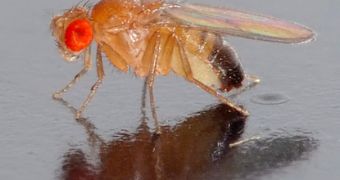Understanding the full extent of the influence that being exposed to microgravity has on human beings is absolutely essential for our ability to conquer space. Since it's economically unsound to conduct such experiments with astronauts, researchers are now turning to fruit flies for answers.
In a new set of tests, scientists subjected the small insects to a type of magnetic fields that can simulate microgravity here on Earth. After placing the fruit flies within the fields, the team stood back and observed how this influenced the way the flies walked.
Studying animals in space have advanced considerably since Laika was launched in orbit, back in 1957. Right now, animals, insects and microorganisms have dedicated compartments on the International Space Station, where astronauts study the effects microgravity has on their behavior.
One interesting thing such studies revealed on the ISS was that Drosophila melanogaster, the common fruit fly, tended to walk more in microgravity than it did back on Earth. The reason for this behavior is largely a mystery even now, Space reports.
In order to study the flies in microgravity, scientists use diamagnetic levitation, says that lead author of the research, Richard Hill. He explains that most biological materials are, indeed, diamagnetic, which means that they are weakly repelled from magnetic fields.
“This is a different type of magnetism from what we're familiar with. What we ordinarily think of as 'magnetic materials' are ferromagnetic materials such as iron – these are strongly attracted by magnetic fields,” says Hill, who holds an appointment as a physicist at the University of Nottingham.
“Diamagnetic levitation doesn't balance gravity as perfectly as 'real' weightlessness does in space, but diamagnetic levitation can be used to see which experiments are suitable and interesting to perform in space before spending the money launching them into space,” he adds.
As soon as the fruit flies were subjected to artificial microgravity, they began exhibiting accelerated walking patterns, very similar to the ones astronauts saw them perform aboard the space lab.
By analyzing the differences between how flies behave in normal gravity and microgravity, researchers can theoretically determine some of the changes that prolonged exposure to reduced gravity could have on humans.
“It's also important to remember that, in our endeavors to explore space – setting up permanent bases on Mars, for example, or other planets – it will be crucial to understand the effects of weightlessness on all living organisms,” Hill says.
“Our survival on permanent off-world settlements will of course require us to take with us many different biological organisms,” he concludes.

 14 DAY TRIAL //
14 DAY TRIAL //